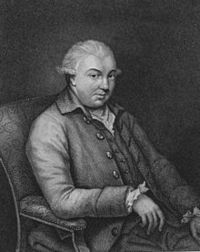Annotation:Lord Kelly (1)
Back to Lord Kelly (1)
LORD KELLY('S RANT/REEL) [1]. AKA - "Lord Kellie’s Reel," "Lord Kellow's Rant," "Lord Kelly's Strathspey." AKA and see "Buckeen (The)," "Cameron House," "George Gubbin's Delight," "Humors of Schull (The)," "Lord Kelly--Strathspey," "Mo ceoil sibh a laochra" "Musical Priest," "New Bridge of Erin (The)," "Old Grey Gander (The)," "Wedding Ring (2) (The)." Scottish, Irish, Canadian, English; Strathspey, Rant or Reel. Canada, Cape Breton. England, Northumberland. G Minor (most versions): G Dorian (Bremner): A Minor (O'Farrell): E Minor (Aird). Standard tuning (fiddle). AB (Surenne): AAB (Athole, Bremner, Gow, O'Farrell): AABB' (Kerr). The tune is supposed to have been an early composition of Thomas Alexander Erskine (1732-1781), 6th Earl of Kelly (or, as he was known "Fiddler Tam"), Scotland's chief composer in the mid-18th century, the early Classical period.

Kelly was a dilettante who lived in Edinburgh all of his life. On his European tour, de rigueur for a young people of class at the time, he studied composition and violin with Stamitz; he almost certainly received training in the Mannheim court orchestra in his early 20's (according to David Johnson). He became a leading light of British music composition during his lifetime, and was a skilled violinist who owned an instrument by the famous German maker Jakob Stainer. Unfortunately, much of his work has been lost, and his surviving output has not been well-regarded in modern times owing to a perceived weakness in composition. His Quartet in C Minor was composed c. 1767 and published for the first time in 2006. John Glen (1891) finds the earliest appearance of the tune in print in Robert Bremner's 1757 collection, and another early printing appears in the 1768 (James) Gillespie Manuscript of Perth. O'Farrell lists the tune as "Scotch." Paul Cranford remarks the tune is among the favorite strathspeys in Inverness County, Cape Breton. See also Erskine's compositions "Minuet for Lord Stanley" and "Duchess of Gordon's Minuet (The)."
Donegal fiddler John Doherty's version of the tune seems to have more in common with the Scottish "Captain Campbell" and "Cameron House," but does have some resemblance to "Lord Kelly." Whether the latter tune is ancestral or not is unknown.
Source for notated version:
Printed sources: Aird (Selection of Scotch, English, Irish and Foreign Airs), 1982; No. 170, p. 59. Anonymous (A Companion to the reticule), 1833; p. 6. Bremner (Scots Reels), 1757; p. 57 (appears as "Lord Kelly's Reel"). Gow (Complete Repository, Part 1), 1799; p. 8 (appears as "Lord Kelly's Strathspey"). Laybourn (Köhler’s Violin Repository Book 3), 1885, p. 246 ("Lord Kellie's Reel"). O'Farrell (Pocket Companion), c. 1805; p. 14. Kerr (Merry Melodies, vol. 3), c. 1880's; No. 185, p. 22. Stewart-Robertson (The Athole Collection), 1884; p. 187. Seattle (Great Northern/William Vickers), 1987, Part 3; No. 477 ("Lord Kellow's Rant"). Surenne (Dance Music of Scotland), 1852; p. 146.
Recorded sources: Rounder CD 11661-7033-2, Natalie MacMaster - "My Roots are Showing" (2000). WMT002, Wendy MacIsaac - "That's What You Get" (1998?).
See also listings at:
Alan Snyder's Cape Breton Fiddle Recording Index [1]
Alan Ng's Irishtune.info [2]
